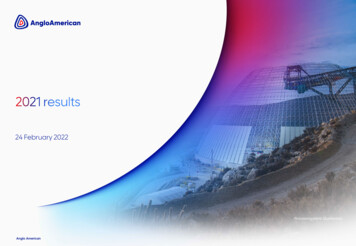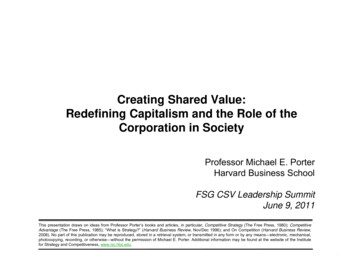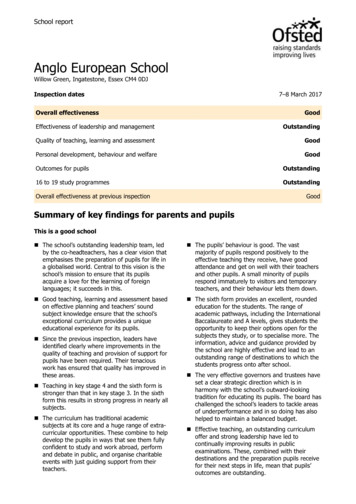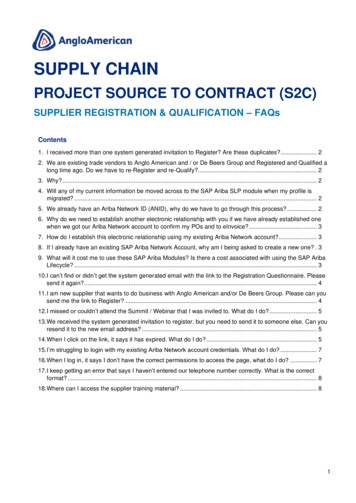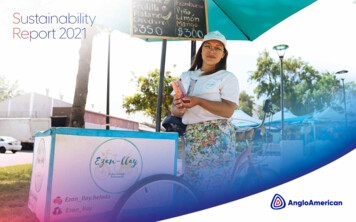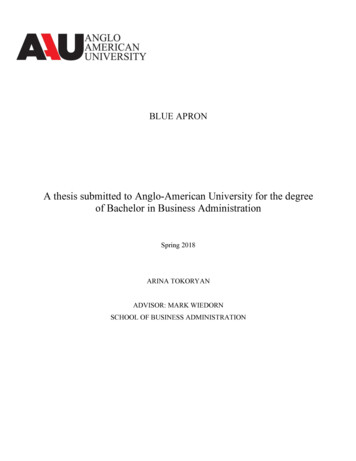
Transcription
BLUE APRONA thesis submitted to Anglo-American University for the degreeof Bachelor in Business AdministrationSpring 2018ARINA TOKORYANADVISOR: MARK WIEDORNSCHOOL OF BUSINESS ADMINISTRATION
Arina TokoryanDECLARATIONI hereby declare that no portion of the work referred to in this thesis has been submitted insupport of an application for another degree, or qualification thereof, or for any other universityor institute of learning.I declare that this thesis is my independent work. All sources and literature are cited andincluded.I also hereby acknowledge that my thesis will be made publicly available pursuant to Section47b of Act No. 552/2005 Coll. and AAU’s internal regulations.Arina Tokoryan1
Arina TokoryanACKNOWLEDGEMENTI would like to express my sincerest gratitude to Mark Wiedorn, my advisor, for hispatience, guidance and wisdom; to Greg Pezda, Luc de Ceuster and Pietro Podda for motivatingme by sharing their passion for business; and to my fellow friends and students for all of thesupport we gifted each other.2
Arina TokoryanTable of ContentsExecutive Summary . . . .61. Introduction . . . .72. Company Overview . . . .82.1 Stock Performance .82.2 Customer Retention . . . .82.3 Rivalry . . .92.4 Mission Statement . . .92.5 Vision Statement . .92.6 Company Overview Conclusion .103. Blue Apron’s Business Model. . . .113.1Value Proposition . 113.2 Customer Segments . .123.3 Channels . . .123.4 Customer Relationships . 133.5 Revenue Streams . . . . . 133.6 Key Resources . . 133.7 Key Partners . . 143.8 Cost Structure . . .143.9 Key Activities . . . .153.10 Current Activity Map . . .173.10.1 Strategic Fit . .213.11 Competitive Advantage . . .224.0 Current Strategy 225.0 Porter’s 5 Tests of Current Strategy 235.1 Distinctive Value Proposition . 235.2 Tailored Value Chain . .235.3 Trade-Offs Different From Competitors . 235.4 Fit Across The Value Chain .235.5 Continuity Over Time . . 243
Arina Tokoryan5.6 Porter’s 5 Tests Of Current Strategy Conclusion . .246.0 Financial Analysis . . .256.1 Net Revenue 256.1.1 Net Income (Loss) .256.1.2 Net Loss From Operating Activities . . 266.2 Profitability Analysis . 266.3 Customer Numbers .266.3.1 Revenue Per Customer . . .276.4 Stock Performance .276.4.1 Earnings Per Share 296.5 Financial Analysis Conclusion . .297.0 External Analysis . .317.1 Industry Overview. . . . 318.0 Competitive Environment . .328.1 Key Competitors . .328.1.1 Amazon . . . 338.1.2 Walmart . . . . 338.1.3 HelloFresh . . 348.2 Competitive Analysis . 348.3 Strategic Group Map 359.0 Porter’s 5 Forces . .379.1 Bargaining Power of Buyers 379.2 Bargaining Power of Suppliers . .379.3 Threat of New Entrants 389.4 Threat of Substitution .359.5 Rivalry Among Existing Competitors .389.6 Porter’s 5 Forces Analysis Conclusion .3910.0 Critical Success Factors . 3911.0 Core Competencies . 4011. Critical Success Factors And Core Competencies Conclusion .4112.0 SWOT Analysis . . .424
Arina Tokoryan12.1 Strengths 4212.2 Weaknesses 4312.3 Opportunities .4412.4 Threats . .4512.5 SWOT Analysis Conclusion . . .4613.0 TOWS Matrix . .4713.1 Strategic Alternatives .4814.0 Current Strategy Restated . .5015.0 Strategic Question Restated 5016.0 Recommended Strategy . .5016.1 Revised Mission and Vision . .5116.2 Suggested Activity Systems Map .5216.3 Recommended Value Proposition . .5317.0 Porter’s 5 Tests Comparison . .5418.0 Strategy Justification and Implementation . 5519.0 Final Conclusion . .57Appendix . 58Company Brief History . . .58Organizational Structure & Management . . 58Company Values . . 59Markets . . 60Products and Services . 61Poor Customer Service . . .62Value Proposition Canvas . . .63Income Statement . . 64Consolidated Statement of Financial Position . 65Works Cited . . .66Bibliography . 705
Arina TokoryanExecutive SummaryThe aim of this paper is to critically analyze the current strategy of Blue Apron, anAmerican meal-kit delivery service company, to further propose potential strategic alternativesfor improvement and to introduce a new recommended strategy.The analysis seeks to address the following strategic question: in 2017, despite reportingsteady revenue numbers, Blue Apron is faced with a number of challenges: stock prices falling70% from the IPO earlier that year along with a 15% decline in customer growth due in part torapidly growing competition. What strategy should Blue Apron undertake in order to regain andsustain its competitive advantage?The company’s performance has been assessed and evaluated in terms of the factors bothinternal and external to the company. An in-depth analysis of the current strategy and itsimplementation along with the industry analysis implications have been performed. Based on theanalysis executed it was possible to identify strengths, weaknesses, opportunities and threatsintegral to the company, which further served as a basis for crafting three new strategicalternatives. Finally, the new recommended strategy was introduced that directly answers thestrategic question posed, which was formulated as follows: to initially partner with a retailgrocery chain to sell the kits in-store while expanding the product portfolio to introduce agreater variety of meal options.6
Arina Tokoryan1.0 IntroductionBlue Apron is an American meal-kit delivery service pioneer. Established in 2012 in NewYork City, the company had quickly gained popularity across the United States due to its uniqueand novel business model. The company’s idea is to provide an alternative to traditional groceryshopping, dining out and ordering takeout from restaurants. It does so by sending their customersboxes with fresh food that has been precisely measured out and packaged in refrigeratedcontainers along with beautiful and easy-to-follow recipe instruction cards. All meals are craftedexclusively by a selection of high-end chefs. Essentially, all the customer has to do is open thebox, unpack the ingredients and get cooking. Blue Apron had delivered a total of 159 millionmeals to 50 states in the US as of 1Q 20171. There are two subscription plans available at themoment — a family plan that serves 4 people for 9.99 per meal and a two-person plan for 8.74per meal. Both plans deliver 3 meals per week.Throughout the company’s lifespan, it has seen a steady revenue pace but is now losingcustomers to other market players while its IPO has been named “the worst performing IPO of2017.2” Blue Apron, although the biggest player on the market at the moment, suffered a majordecline in order sales followed by a sharply thinning customer count in the face of intensifyingcompetition. Thus, the following strategic question is posed: in 2017, despite reporting steadyrevenue numbers, Blue Apron is faced with a number of challenges: stock prices falling 70%from the IPO earlier that year along with a 15% decline in customer growth due in part torapidly growing competition. What strategy should Blue Apron undertake in order to regain andsustain its competitive advantage?1Blue Apron Still Dominates the Market For Meal Delivery Kits but Its Market Share Is PlummetingRani Molla - esh Rani Molla - esh 2Blue Apron: No Closer To Recovery Than Ever Before n-closerrecovery 7
Arina Tokoryan2.0 Company OverviewPlease refer to section Company Details in the Appendix for the strategic overview2.1 Stock PerformanceFollowing a series of revenue-generous years with the service becoming more widelyrecognized by the US population, Blue Apron took the chance to file for their initial publicoffering to trade at New York Stock Exchange in June 2017. Their target price was initially setbetween 11 and 15, but the company ended up with an offer price of 10 per share. BlueApron’s IPO received a lot of attention from both the general public and the investors, because itsymbolized the triumph of the meal kit services within the food delivery industry.Since their initial public offering, the stock has fallen more than 70% and seems to keepon plunging. In February 2018, Blue Apron stock trades at 3.10 per share3.2.2 Customer RetentionBlue Apron has seen a 15% decline in customer base since the year 2016.4 The mainreason for that is the ‘war on price’ due to increased industry competition. According to L.E.K2016 Millennial Retail and Travel Survey, 57% of Americans discontinue their subscription tomeal-kit services due to the service being too expensive5. Blue Apron’s business strategy impliesoffering lower industry prices ( 9.99 per person per meal for a two-person plan and 8.74 perperson per meal for a four-person plan)6 and it is still losing customers. Blue Apron gives away alot of free meals to woo new subscribers, but ends up losing them due to an extremely highcustomer churn with only 29% of the customers sticking around a year after the initial sign up7.The main reasons for customers canceling subscription are meal option variety andcustomer service (please see section Poor Customer Service in the Appendix).3Aprn : Summary For Blue Apron Holdings Inc https://finance.yahoo.com/quote/APRN?p APRN 4Blue Apron Holdings, Inc. 10-k Feb. 22, 2018 5:18 Pm https://seekingalpha.com/filing/3899796 5Why A Shakeout IN Meal Kit Industry Is Likely Executive Insights dfattachments/1948 Shakeout Meal Kit Industry LEK Executive Insights v2.pdf 6Blue Apron: Fresh Ingredients, Original Recipes, Delivered to You http://www.blueapron.com 7Amazon and Blue Apron: Why Meal Kits Haven’t Changes Cooking n-cooking/ 8
Arina TokoryanFigure 1. “What are the primary reasons you do not plan to continue purchasing from meal kit companies? Select up to 3responses.” The main reason for cancelling subscription is that the service is too expensive, followed by poor recipe range andvariety, packaging issues and bad customer service. Source: L.E.K. 2016 Millennial Retail and Travel Survey. Respondents wereaskedFigure 1 suggests that customers cancel their meal kit subscription because they do notfind the service affordable.2.3 RivalryBlue Apron has made significant financial effort to try to battle the intense competitionmostly by investing heavily into marketing and advertising and launching a new productioncenter with more efficient operational structure to support the production activities. Blue Aprondoes not compete aggressively against its rivals due to the lack of effective corporate strategy,thus losing customers to rivals that may offer better deals on the service.2.4 Mission StatementBlue Apron’s mission is formulated as follows: “Our mission is to make incredible homecooking accessible to everyone.” 8This mission statement is ineffective due to a number of reasons. First, it is too broad,unclear and lacks further explanation of how the mission is to be achieved. Second, it lacks theexplanation of its strategic positioning within the market, values that the company holds and itstarget group or region.The recommended mission statement for Blue Apron is introduced in Section 16.1Revised Mission and Vision.2.5 Vision StatementBlue Apron’s vision statement is as follows: “Our vision for the future is ambitious: tobuild a better food system. We are transforming the way that food is produced, distributed, and8FORM S-1 REGISTRATION STATEMENT UNDER THE SECURITIES ACT OF 1933 Blue Apron Holdings, Inc. - 0104746917003765/a2232259zs-1.htm 9
Arina Tokoryanconsumed. We believe a better food system will benefit not only consumers and stockholders,but also the planet, and we manage our business for the benefit of all three.”9This vision statement sets forth the company’s focus on sustainability and bettering theenvironment. However, the vision statement does not provide clear direction of where thecompany is going in terms of its operations. Building a better food system is not a strategic goalfor the company because it is, in the end, a for-profit organization that has to generate revenue. Itdoes not provide a clear vision of how the company will look like or be structured in 5-10 yearstime.The recommended vision statement for Blue Apron is introduced in Section 16.1 RevisedMission and Vision.2.6 Company Overview ConclusionBlue Apron’s market position, low customer satisfaction and a badly performing IPOshow a worrisome trend of customer loss due to inability to battle competitors, promote customerloyalty or offer a unique enough service to differentiate the product. The company’s vision andmission statements are not articulated clearly to portray what Blue Apron’s corporate strategy isand where the company is going.9FORM S-1 REGISTRATION STATEMENT UNDER THE SECURITIES ACT OF 1933 Blue Apron Holdings, Inc. 00104746917003765/a2232259zs-1.htm10
Arina Tokoryan3.0 Blue Apron Business ModelValueService convenience, Focus on sustainability, Innovative idea, Sense of self-Propositionfulfillment with cookingCustomerSegmentsYoung adults & millennials, Med-higher income families, UrbanitesChannelsWebsite sales, Variety of advertising activitiesCustomerOnline subscriptions, Automated service, Limited personal assistanceRelationshipsthrough customer serviceRevenueStreamsKey ResourcesKey ActivitiesKey PartnersCost StructureMeal-kit subscriptions (primary), Sales of products of subsidiariesProfessional chefs creating recipes, Fulfilment centers, Online salesplatform (website), Intellectual PropertyRecipe crafting, Meal-kit assembly, Managing supply chain, Managingdistribution platform, Service marketingFarmers, Food Suppliers, Logistics companies, Loyal customersSalaries and wages, Operating expenses, Marketing expenses, Fulfilmentcenter servicing3.1 Value Proposition (please see Appendix for the Value proposition canvas)Blue Apron’s value proposition adheres to convenience, accessibility and newness toprovide a unique service to the customer. The company’s value proposition can be formulated asfollows: “To offer the convenience of food delivery service to let customers enjoy sophisticatedhome-cooked meals at moderate prices while promoting sustainability.”This value proposition delivers to a number of customers’ needs, wants and desires. First,it offers a convenient, accessible and moderately priced service to the customer, which is one ofthe main reasons for the subscription purchase due to a simple and quick online order process,speedy delivery and preselected menu options. Neatly designed packages, pre-portioned11
Arina Tokoryaningredients and recipe brochures are also coherent with the value proposition. All of theaforementioned points are targeted to trigger the customer’s desire to cook at home, try newrecipes and enjoy simple ordering process with Blue Apron. On top of that, Blue Apron lets thecustomer be a part of “something big” by focusing on sustainable food system and letting theircustomers know that by cooking with Blue Apron they are helping the planet by reducing waste(no leftover food) and supporting organic farms and purveyors.Customer’s desire for unique and luxury cooking experience are met with Blue Apron’sexclusive chef-crafted meal recipes, which adds to the customer satisfaction and provides a senseof self-fulfillment, further fostering emotional connection to the brand.3.2 Customer SegmentsConstituting it as one of the key points the company prides itself on, Blue Apron aims todeliver its value proposition to mass market, positioning its service to be widely available andeasily accessible to virtually anyone.While the company attempts to target a wide range of customers, its typical subscriber isa single or newly married professional living in an urban area, aged 25-44.10 A broader customerrange is one of the key areas that Blue Apron can improve upon.The majority of the clients are located in large cities across the United States (57% livingin top 10 states)11 and often do not have the time or will to decide on meals to prepare at home ortake grocery shopping trips, which means they are extremely time-sensitive and choose to usethe service due to its convenience. Blue Apron customers (especially returning ones) are usuallythose within medium to high income brackets, mostly because the service is perceived aspremium.3.3 ChannelsThe only distribution channel the company operates through is direct web sales. BlueApron only uses its website to sell and deliver the meal-kit boxes and its supplementary productsand provide customer support.10Blue Apron Holdings, Inc. 10-k Feb. 22, 2018 5:18 Pm https://seekingalpha.com/filing/3899796 11Blue Apron Holdings, Inc. 10-k Feb. 22, 2018 5:18 Pm https://seekingalpha.com/filing/3899796 12
Arina TokoryanTo attract and retain customers, Blue Apron raises brand awareness throughadvertisements and promotions — online (mostly on social media and partner websites throughdigital advertisement), on TV and offline (street signs, banners, etc.).This is another key area for improvement that Blue Apron should consider.3.4 Customer RelationshipsBlue Apron has little to no direct interaction with a customer ordering meal-kit boxes,hence the self-/automated service nature of customer relationship. Any customer can easilysubscribe to the service without any service assistant to further receive scheduled deliveries ofthe meal-kits to the door — the whole process is fully automated. There exists a customer serviceline to resolve issues or file a complaint.3.5 Revenue StreamsThe company generates revenue mainly from the sale of their meal kits (subscription costfor 2-Person or Family Plan). The company also generates revenue from Blue Apron Wine, aBlue Apron’s subsidiary that sells selected wines and Blue Apron Market, which offerssupplementary items such as kitchen utensils, cutlery, cookware and pantry supplies (like salt,pepper, chocolate, olive oil). Blue Apron also sells products of BN Ranch, a producer ofsustainable poultry and meat, which was acquired by the company in February 2017. Blue Apronhas claimed that the substantial amount of its revenue is generated from the sale of meal kits,which it is their primary revenue stream, with other sources of revenue being onlysupplementary.12Evidently, due to gross profit margins being very thin (30% average) and net profitmargins being negative (-20%, FY2017)13, a single primary revenue stream may not be enoughto sustain a business in the face of competition and grow profits in the industry where switchingcosts are close to nonexistent or extremely low.3.6 Key ResourcesUnique combination of assets that Blue Apron possesses to deliver its value propositionto the customer and optimize allocation of resources and activities consists of human, intellectualand physical resources.12Blue Apron Holdings, Inc. 10-k Feb. 22, 2018 5:18 Pm https://seekingalpha.com/filing/3899796 13Blue Apron Holdings (aprn) https://ycharts.com/companies/APRN 13
Arina TokoryanBlue Apron relies heavily on its physical resources such as fulfillment and operationscenters to receive, prepare, package and ship meal-kits. Similarly, human resources — workersand specialists working in these centers — are also crucial to the successful execution of thebusiness model. One of the key resources Blue Apron has are tied with the partnerships thecompany has established (intellectual resource) with its supply chain — farmers, distributors,logistics partners.3.7 Key PartnersOn-time delivery of high-quality fresh ingredients is essential to Blue Apron’s businessmodel optimization, thus supply and logistics partners are key for the company to quicklyreceive, prepare and deliver fresh ingredients to the customer at reasonable time and cost througheliminated third parties. Blue Apron’s main logistics partners are FedEx and UPS.14The company also puts a lot of effort into promoting its sustainability program, wherebyit focuses on eliminating food waste by carefully pre-portioning meal-kit ingredients, using onlyhighest quality farm meat and produce and ensuring no food spoilage through eliminatedmiddlemen (store warehouses, grocery stores, etc.).To be able to accomplish that, a number of key partnerships with local and internationalfarmers, importers and artisans are essential. Blue Apron establishes exclusive contractualrelationships with most of its food suppliers, which means that, within the meal kit deliveryindustry, they are only able to sell to Blue Apron.One of the major ex-suppliers — now Blue Apron’s subsidiary — of beef, lamb andpoultry, BN Ranch, is globally recognized as “pioneer of animal welfare”15 and “godfather ofsustainable meat”16. A number of other organic farms are exclusive company partners, like RumiSpice (Afghani company), Sun Noodle (New Jersey), Severino (New Jersey), Vermont Creamery(Vermont), Reeves Farms (New York)17, and many others.3.8 Cost Structure14Blue Apron and the Subscription Retail Supply Chain ron-and-the-subscription-retail-supply-chain/ 15BN Ranch www.bnranch.com 16Blue Apron Just Partnered with the Godfather Of Sustainable Meat - and the Move Will Transform Its Meal KitsLeanna Garfield - an-bn-ranch-2017-3 17Meet Our Recent Partners rtners 14
Arina TokoryanBlue Apron opts to deliver the highest value to the customer, hence the value-drivenapproach and a handful of major cost drivers.Due to the nature of the business being reliant on timely delivery of ingredients tofulfillment centers and then of the meal-kit boxes to the customers, Blue Apron spends a chunkof its expenses on shipping and last mile delivery logistics (about 20-30% of total cost)18.Alongside logistics costs, production and operating expenses are rather costly for the company— especially with the servicing of the newly opened fulfillment center in New Jersey. Marketingexpenses, though recently cut from 17% to 13%19 to fulfill the new operations center, are nowpulled back up to account for a major cost activity for Blue Apron, as well as supply chainactivities, exclusive partnerships and human resource expenses.3.9 Key ActivitiesFigure 2. The above visual reflects the current Blue Apron business model and its end-to-end value chain. First, thecompany partners with farmers and suppliers of organic and sustainable food to later deliver to the company’s fulfillment centersfor quality control, packaging and boxing. Next, meal kit boxes are being delivered to the customer’s door. Customers then cancook their meal with Blue Apron’s meal kit. The above activities reflect several key components that are of value for the currentbusiness model: fresh and organic food, efficient and effective supply and distribution network, customers’ convenience andunique cooking experience. Author: Arina Tokoryan, 2018.The main activities Blue Apron performs in order to successfully deliver superior valueto the customer are directly related to production, optimization and distribution of the service andalso the way the company manages its supply chain network to support the main activities.18Shipping Plays Costly Role in Meal Kit Delivery, Jennifer McKevitt - l-kit-delivery-logistics/445653/19Blue Apron Shares Jump After Losses Narrow -b9ccc4c4dbbb 15
Arina TokoryanWhile the company outsources food production and most logistics operations, it relies onrunning its fulfillment and operations centers. Huge production areas (the new fulfilment centerin Linden, NJ is 495 000 square foot and employs around 2 000 people) receive, quality control,prepare, package, store (refrigerate) and ship vast amounts of food, so the coordinated productionsystem is a must for the company. As a newly employed program, the new fulfilment centersnow operate an automated operations and inventory management system which ensures a smoothand timely production of service.Another key activity Blue Apron undertakes is managing its supply-distribution networkin a such a way that each of the company’s affiliates and partners works exclusively with BlueApron (within its industry) to offer the highest quality product and service.16
Arina Tokoryan3.10 Current Activity Systems Map17
Arina TokoryanCreating a unique home-cooking experiencePre-portioned, boxed ingredients with recipe brochuresAn activity that provides customers with the unique home-cooking experience and addsto the novel, innovative business model, — whereby a customer receives a box of pre-portionedmeasured ingredients to cook at home.In addition to the pre-measured ingredients, customers receive an elegant recipe brochurewith cooking steps illustrations. Customers enjoy aesthetically looking things and Blue Apronacknowledges this fact by creating sophisticated recipe brochures, that almost look like they arehand-crafted. This adds appeals to the customer by further strengthening the emotionalconnection to the brand.Home delivery/effective outbound logisticsSupporting the main activity, efficient and coordinated outbound logistics system adds tothe customer experience and gives a sense of commitment to the brand. Coordinated andefficient outbound logistics system greatly supports the main activity.Top-tier chefs crafting recipesBlue Apron prides itself on partnering with the top, award-winning chefs to create recipesfor them. Customers get a sense of uniqueness knowing that the recipes they cook at home wereexclusively crafter ‘for them’ by top-tier professional chefs. This activity supports the brand’scustomer value focus.Additional goods available for purchaseThere is a number of supplementary products available for purchase that Blue Apronoffers. Besides kitchen cutlery and pantry supplies available on Blue Apron Market, thecompany sells an exclusive selection of wine along with the meal pairing tips, which furthersupports customers experience and adds to the activity uniqueness. All wine is sold through BlueApron subsidiary — BAW (Blue Apron Wine). Customers can customize their meal kitsubscription in such a way that they would receive a bottle of selected wine with each meal.Original and exotic recipes with sophisticated and scarce ingredientsBlue Apron further supports the creation of unique home-cooking experience by craftingoriginal and sophisticated recipes often with the use of scarce and rare ingredients — somethingthat customers would not normally prepare themselves. This activity adds to the customer value.18
Arina TokoryanCustom distribution networkReliance on customers’ brand awareness & connectionBeing a meal-kit pioneer and having earned a powerful brand name within its industry,Blue Apron relies heavily on its brand awareness and recognition, along with the customers’connection to the brand, which results in a customized distribution network (loyalcustomers new customers those customers telling potential customers about the brand).Heavy advertisementSince inception, Blue Apron relied heavily on marketing and advertising, as these are oneof the only activities the company can perform in order to acquire and retain customers.Marketing expenses have been significantly cut last year due to servicing the company’s newfacility, causing the customer base to shrink greatly. Thus, advertisement is the company’s keyactivity within the distribution network.Direct-to-consumer online platform & ordering systemSimple and intuitive, Blue Apron’s direct-to-consumer online order platfo
Apron's IPO received a lot of attention from both the general public and the investors, because it symbolized the triumph of the meal kit services within the food delivery industry. Since their initial public offering, the stock has fallen more than 70% and seems to keep on plunging. In February 2018, Blue Apron stock trades at 3.10 per share3.

